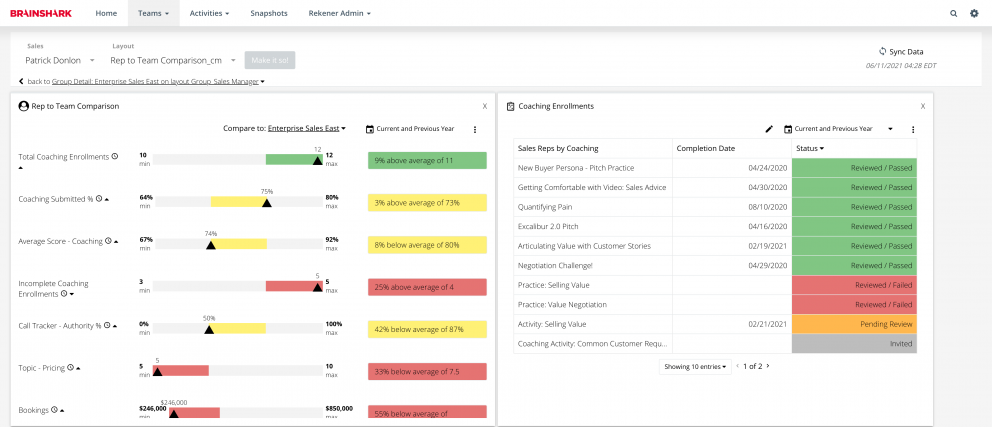Top 5 coaching tips for sales managers, plus how to get started

Challenges for organizations with untrained or undertrained reps include missed quotas, inconsistent messaging, and lack of sales readiness. All of these issues can be improved with effective sales coaching, but sometimes, getting started can feel overwhelming.
On top of that, many people don’t like change, and the excuses for putting coaching on the backburner can seem endless. Here’s a brief overview of what effective coaching looks like in 2024, along with a few accessible ways you can introduce (or reintroduce) coaching to your sales organization.
What is sales coaching?
Sales coaching is the process of evaluating reps’ skills, knowledge and readiness, and providing feedback for continuous performance improvement.
Research firm CSO Insights offered this more formal definition:
Sales coaching is a leadership skill that develops each salesperson’s full potential. Sales managers use their domain expertise along with social, communication, and questioning skills to facilitate conversations with their team members that allow them to discover areas for improvement and possibilities to break through to new levels of success.
Coaching is often led by sales managers and facilitated by sales enablement professionals. Many companies provide in-person coaching (i.e., roleplays) where managers might define specific scenarios and see how reps handle them in a simulated environment. The manager can then point out the reps’ strengths and areas of improvement and define steps they can take when it’s time to meet with buyers.
Sales coaching tools can aid this process in a big way, especially in today’s world where more takes place virtually.
This type of technology includes video coaching tools, which allow sales managers and sales enablement professionals to create and assign video coaching activities. They define a question or situation and ask the rep to record a response via video.
From there, the manager can evaluate the response and provide feedback to help reps improve their skills. These tools make the coaching and feedback process virtual, scalable, and easy to manage, especially for large or distributed sales teams.
There are other types of coaching tools, including technology that tracks and evaluates reps’ meeting and call recordings, sales activities, and written materials (such as emails). Sales readiness platforms also include coaching modules, such as video coaching activities, AI-powered analysis, and manager and peer feedback.
You can get an idea of how sales coaching technology with AI feedback works right here:
Why is sales coaching important?
Sales coaching is essential for many reasons. First, it helps reps continuously improve their performance through feedback, practice, and repetition. Next, it allows sales managers to improve sales processes, training techniques, and pinpoint progress and areas of improvement for their teams. Most importantly, coaching has a significant impact on results. According to CSO Insights, companies with a formal approach to sales coaching experience 10% higher win rates.
If companies don’t have the right approach, the results reflect that. CSO Insights found that an informal or laissez-faire coaching strategy (where the process is up to sales managers alone) can hurt win rates significantly.
Related: Why is Sales Enablement Important? 5 Reasons and Examples
What does a sales coach do?
While many organizations leave coaching up to sales managers, some hire a dedicated sales coach purely focused on helping reps develop the skills needed to have meaningful buyer conversations.
The day-to-day duties of a sales coach include one-on-one coaching, role-play sessions, critical feedback, and deal collaboration.
Top 5 tips to improve your sales coaching
- Determine where your reps need help
- Start small and stay relevant
- Create a variety of coaching scenarios
- Share it with the class
- Actively seek out internal and external resources
1. Determine where reps need the most help
When developing a sales coaching program, it’s essential first to determine where each sales rep needs the most help. To figure this out, try a data-driven approach that compares your team’s performance against benchmarks to spot weaknesses in areas such as pipeline conversion ratios instead of targeting areas at random. Learning Scorecards like those shown below help illuminate gaps in your team’s skill sets so you can provide strategic coaching in those areas.

Coaching will have a much more significant impact if you purposefully target areas that reps are struggling with and use your limited time wisely on reps who need the most help. As you can see in this Scorecard, Patrick needs more coaching on selling value to bring up his bookings.
2. Start small and stay relevant
Since you’re already walking into a situation where there may be resistance to change, think about how you can gain early momentum.
If you’re doing in-person coaching, have reps act out a simple scenario in a roleplay, such as recording a voicemail to a prospect and give them feedback on their delivery and messaging. With video coaching tools, you can start even smaller since they’re going to be learning how to use the technology as well.
For example, create introductory activities asking reps to respond to a simple question, such as what is your favorite restaurant and why?
By starting small, you can get reps warmed up to the idea of coaching and get them accustomed to different types of coaching – one-on-one with a manager or via a video coaching platform. After getting a few ‘at-bats’ under their belts, the following few coaching activities will be a lot easier.
They may also be more comfortable (and feel less judged) starting with RoleplayAI that emulates customer conversations in low risk scenario.

3. Create a variety of coaching scenarios
There are many stages of the sales cycle and aspects of a deal that cause reps to flex different selling muscles. Sales coaching programs shouldn’t be limited to one flavor but should target different skill sets and levels of experience.
For example, you may want to coach newer reps on how to deliver an effective elevator pitch since they’ll still be learning essential product and company messaging. Veteran reps might benefit more from being coached on a specific scenario, such as how to cross-sell or upsell one of their existing accounts.
Quick Tip: Try incorporating a round-robin style question-and-answer into your coaching sessions, where each rep focuses on a narrow aspect of the sales process. (Example: What three questions could you ask of a sales leader whose company just acquired or merged with another firm?)
4. Share it with the class
Coaching shouldn’t just be limited to the one-on-one time between the manager and the rep. It helps to have the whole team involved because reps can learn just as much from each other as they can from you.
Share both the good and the not-so-good responses from coaching activities and have reps give peer feedback. Doing this can help new or struggling reps learn from high-performing reps. It can also help any rep learn new pointers on improving or taking a different approach to finding quick wins. Video coaching tools make this process super easy by allowing reps to send recordings to managers and peers for full-circle feedback. Plus, sales managers can save the best responses and add them to courses or curriculums.
Peer feedback can also help when you have a geographically dispersed sales team. It can form bonds between reps who may never interact regularly and develop a team feeling of working toward a common goal. It also takes some pressure off the sales manager to be the only source of constructive criticism or praise.
5. Actively seek out internal and external resources
If you’re new to coaching or trying to get your program going again, you don’t have to go it alone. Internally, lean on sales managers, sales reps, and sales leaders for ideas and inspiration for the types of coaching activities most valuable to the sales team. Externally, there are all kinds of resources such as thought leadership, best practices, and other sales enablement professionals in the same boat!
Sales coaching resources:
- Coaching for Peak Performance: Techniques Sales Leaders Can Take from Sports Coaches
- What vibes help you sell? How AI-powered sales coaching improves your pitch
- The Business Case and Playbook for Data-Driven Sales Coaching
- Quick and complete guide for sales teams: What to do, what not to do, plus sales coaching activities you can use right now
- How to create a coaching culture in your organization

